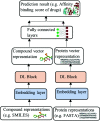New Insights Into Drug Repurposing for COVID-19 Using Deep Learning
- PMID: 34546931
- PMCID: PMC8843052
- DOI: 10.1109/TNNLS.2021.3111745
New Insights Into Drug Repurposing for COVID-19 Using Deep Learning
Abstract
The coronavirus disease 2019 (COVID-19) has continued to spread worldwide since late 2019. To expedite the process of providing treatment to those who have contracted the disease and to ensure the accessibility of effective drugs, numerous strategies have been implemented to find potential anti-COVID-19 drugs in a short span of time. Motivated by this critical global challenge, in this review, we detail approaches that have been used for drug repurposing for COVID-19 and suggest improvements to the existing deep learning (DL) approach to identify and repurpose drugs to treat this complex disease. By optimizing hyperparameter settings, deploying suitable activation functions, and designing optimization algorithms, the improved DL approach will be able to perform feature extraction from quality big data, turning the traditional DL approach, referred to as a "black box," which generalizes and learns the transmitted data, into a "glass box" that will have the interpretability of its rationale while maintaining a high level of prediction accuracy. When adopted for drug repurposing for COVID-19, this improved approach will create a new generation of DL approaches that can establish a cause and effect relationship as to why the repurposed drugs are suitable for treating COVID-19. Its ability can also be extended to repurpose drugs for other complex diseases, develop appropriate treatment strategies for new diseases, and provide precision medical treatment to patients, thus paving the way to discover new drugs that can potentially be effective for treating COVID-19.
Figures






References
-
- Balasubramaniam M. and Shmookler R. R., “Computational target-based drug repurposing of elbasvir, an antiviral drug predicted to bind multiple SARS-CoV-2 proteins,” ChemRxiv, pp. 1–20, Apr. 2020.

